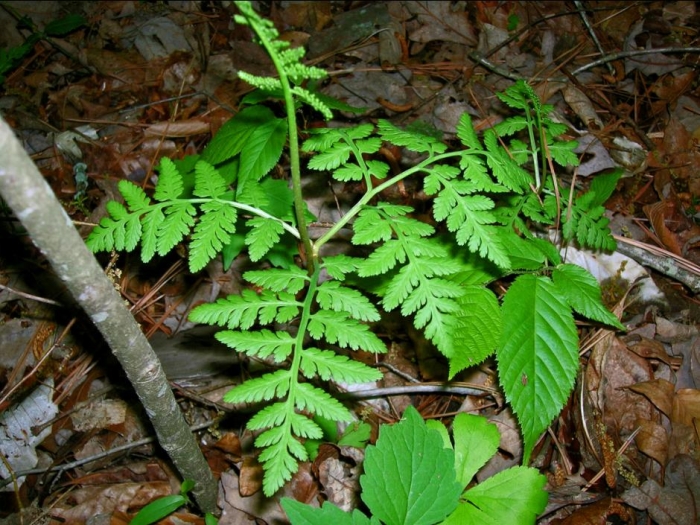Rattlesnake Fern
(Botrypus virginianus)
Rattlesnake Fern (Botrypus virginianus)
/
/

TheAlphaWolf
CC BY-SA 3.0
Image By:
TheAlphaWolf
Recorded By:
Copyright:
CC BY-SA 3.0
Copyright Notice:
Photo by: TheAlphaWolf | License Type: CC BY-SA 3.0 | License URL: https://creativecommons.org/licenses/by-sa/3.0 | Uploader: TheAlphaWolf | Publisher: Wikimedia Commons | Title: Botrychium_virginianum.JPG | Notes: |



























Estimated Native Range
Summary
Botrypus virginianus, commonly known as Rattlesnake Fern, is a perennial fern in the adders-tongue family. It is native to rich, moist, deciduous forests, often in areas with limestone-derived soils, and thrives under dense shade, avoiding direct sunlight. This fern typically reaches up to a foot in height and has a distinctive triangular frond that emerges in early spring and senesces by late summer. The frond is divided into sterile leafy segments and a fertile spike bearing spores.
Rattlesnake Fern is appreciated for its unique foliage and is used in shaded woodland gardens and naturalized areas. It requires consistently moist soil and does not tolerate drought well. In cultivation, it is important to mimic its natural habitat by providing ample shade and moist, humus-rich soil. While not commonly used for culinary purposes in most of its range, it is notable that in the Himalayas, it is boiled and eaten. Care should be taken to avoid overexposure to sun, which can damage the fern.CC BY-SA 4.0
Rattlesnake Fern is appreciated for its unique foliage and is used in shaded woodland gardens and naturalized areas. It requires consistently moist soil and does not tolerate drought well. In cultivation, it is important to mimic its natural habitat by providing ample shade and moist, humus-rich soil. While not commonly used for culinary purposes in most of its range, it is notable that in the Himalayas, it is boiled and eaten. Care should be taken to avoid overexposure to sun, which can damage the fern.CC BY-SA 4.0
Plant Description
- Plant Type: Fern
- Height: 0.5-2 feet
- Width: 0.7-0.8 feet
- Growth Rate: Moderate
- Flower Color: N/A
- Flowering Season: Non-Flowering
- Leaf Retention: Deciduous
Growth Requirements
- Sun: Part Shade, Full Shade
- Water: Medium
- Drainage: Medium
Common Uses
Bird Garden, Deer Resistant, Low Maintenance
Natural Habitat
Native to rich, moist, deciduous forests, often in areas with limestone-derived soils, thriving under dense shade
Other Names
Common Names:
Scientific Names: Botrychium virginianum , Botrypus virginianus , Botrychium virginianum f. virginianum , Botrychium virginianum var. europaeum , Botrychium cicutarium , Botrychium virginianum var. mexicanum , Botrychium virginianum subsp. europaeum , Japanobotrychum virginianum , Botrychium virginianum var. laurentianum , Botrychium dichronum
GBIF Accepted Name: Botrypus virginianus (L.) Michx.